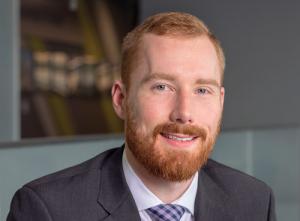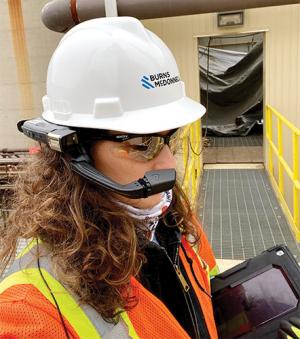Burns & McDonnell
Zachary Wassenberg helps lead assisted reality technologies enterprise deployment as XR Innovation Manager at Burns & McDonnell.
PUF's Steve Mitnick: You came up with something wearable at Burns & McDonnell. What does it do?

Zachary Wassenberg: This wearable is basically a normal tablet. The name is HMT, which stands for Head-Mounted Tablet. One of the important parts about this tablet is instead of the normal point and click like you would on a normal handheld tablet or cell phone, it's all voice activated.
What we've tried to do working in partnership with our vendors is take some of the most valuable parts of the tablet experience in the utility world todayand tried to migrate that into a hands-free voice activated device.
That's what we've been using it a lot for, especially during the pandemic, is video conference calling, and then being able to address a lot of the issues around proper documentation of inspections and work processes.
Since it's a wearable device, safety is a big part of it. Instead of looking down at a tablet or a cell phone, we can do that on a wearable and just glance at it with peripheral vision. In general, the big use case is video conference calling, but we are starting to see a lot of traction around the ability to gather field data and execute work processes digitally now.
 Zachary Wassenberg: In most utility applications, you’re going to be wearing a hard hat. For this device, the RealWear device, it has standard hardhat clips where you can clip the HMT directly into a standard MSA V-Guard Hard Hat, or a Honeywell Hard Hat and it clips right in there.
Zachary Wassenberg: In most utility applications, you’re going to be wearing a hard hat. For this device, the RealWear device, it has standard hardhat clips where you can clip the HMT directly into a standard MSA V-Guard Hard Hat, or a Honeywell Hard Hat and it clips right in there.
PUF: How does someone wear it?
Zachary Wassenberg: In most utility applications, you're going to be wearing a hard hat.
For this device, the RealWear device, it has standard hardhat clips where you can clip the HMT directly into a standard MSA V-Guard Hard Hat, or a Honeywell Hard Hat and it clips right in there.
If you don't have one of those types of hard hats, and you like to do things your own way, you can zip tie it to other hard hats. For those people who don't wear hard hats in their day to day, some of the environmental specialists who work for utilities, they can wear a baseball cap. There are some other ways to wear it, too. You can wear it with a work band, or you can wear it with a baseball cap strap, and RealWear sells a variety of accessories.
It depends on what your work application is, and what you're more comfortable with. My recommendation and preference are to use the hard hat. It does a good job ergonomically spreading that weight out across the hard hat.
Ergonomics is a big part of this technology. Since you're going to be using it eight hours a day, you want it to be comfortable. Many of the users I've trained have given me feedback that once you put it on, you notice a slight increase in the weight, but as you use it, you quickly no longer notice it and start using it as part of your normal process.
PUF: What kind of folks are using this?
Zachary Wassenberg: The pandemic has driven usage up tremendously across Burns & McDonnell. We were fortunate in that we got our fully functioning enterprise system up and running in March, which was perfect timing to help combat the lockdown around COVID and some of the travel restrictions and safety concerns.
I put together a quick training for the RealWear HMT, which looks a little bit like Boba Fett's eye piece from Star Wars, which is what inspired the hardware when you look at the history of it. It looks a bit odd. However, it is quite easy to pick up and use.
It's made to be able to be picked up by someone who's not used to technology. Maybe they've been in the utility industry for a long time. They're used to pen and paper.
It's meant to be used by someone who can easily pick it up and understand it. I've done quite a number of trainings across sectors, not just the utility sector. That includes oil and gas, aviation, facilities, and transportation.
For every one of the industries that we've served, we use this with some outstanding results. It takes about forty-five minutes to an hour to fully go over the technology with someone who's never used it before in the field.
Then my recommendation is practice always makes perfect. I always recommend an hour of practice afterward. Someone who's never used it before can use it proficiently in about an hour to two hours.
It's staggering but because of COVID, I've trained somewhere around three hundred people on the technology.
We ship it out to a location where they need it. We've got the devices spread across the United States and Canada to help support our clients geographically.
PUF: How did this come about?
Zachary Wassenberg: The inception of the idea came about when I was in college at Kansas State University. The Google glass product had just come out and I was watching a YouTube video about it. That product maybe missed the mark a little bit, trying to go toward the consumer market.
They have since readjusted and are now going after the industrial market with that product. But what brought this idea to where it is today was Burns & McDonnell has an internal innovation program called Ignite, which launched in August of 2016. I submitted my idea to this internal innovation program.
It's a three-phase program where they slowly filter out ideas until there is a final five. I was fortunate I made it to the final day where you give a presentation to the board of directors and the officers at Burns & McDonnell.
I went to talk with John Olander, our chief operating officer and president of the Transmission & Distribution Group. I said, I believe this is an important idea to the future of the industry and the company and I'd like to spend time working on it. I'd like to research it and go forward. John supported me.
Over the course of those four years, I did market research, and found a partnership in the VisualSpection software product developed by Manitoba Hydro, the Canadian gas and electric utility.
When we started working with them, we did the pilot and made it to where we are today with the enterprise level agreement. I now have the great pleasure of managing that internal innovation program - Ignite.
It's come full circle and says a lot to the entrepreneurial spirit at Burns & McDonnell. It's not every organization where an officer and member of the board of directors is going to give you permission as an entry level engineer to work on innovative projects.
PUF: Where do you think this is going?
Zachary Wassenberg: In the next two to four years, you'll start to see the foreman and managers of the crews have them in their everyday work, from a safety stance. It is a commercially viable product right now, but it takes time to adopt new technologies.
You'll see the management onsite, and the foreman onsite with them. After a while, you'll probably start to see the everyday journeymen, the linemen start to use these on their normal processes.
We'll eventually get to where this is as commonplace as a cell phone, but it will never replace a cell phone. That'll always be in someone's pocket, but from a safety perspective, especially in the utility industry, we'll get more familiar with this type of technology.
Executives at utilities will see this not just as a piece of technology that's going to help us reduce costs and make us more effective. They're going to see it as a risk reduction tool with, how do I make my people hands free?
That way, when they want to use a digital device like a cell phone, they don't have to take their gloves off, or they're not distracted when they look down. At its core, it's a safety technology and it's just going to take time for that to be proven out, as safety is not the easiest thing to track. It's a soft metrics sometimes. It takes deployments before people start to see that.
Profiles in Innovation
- Arron Pauley, Ameren Missouri
- Girija Sathyamurthy, Ameren
- Zachary Wassenberg, Burns & McDonnell
- Geoff Blanford, EPRI
- Maria Guimaraes Biagini, EPRI
- Anil Kondabathini, HyoJong Lee, Reynaldo Nuqui, and Jiuping Pan, Hitachi ABB Power Grids
- Dave Geier and Stephen Johnston, San Diego Gas & Electric
- Alyssa Grigoryan, Kathy Hidalgo, Sunanda Singh, and Lucero Vargas, Southern California Edison


